Effect of Laser Shock Peening without Coating on Grain Size and Residual Stress Distribution in a Microalloyed Steel Grade
Abstract
:1. Introduction
2. Experimental Procedures
2.1. Material Selection and Sample Preparation
2.2. Laser Shock Peening without Coating (LSPwC)
2.3. Residual Stress Measurements and Electropolishing
2.4. Microstructural Characterization
2.5. Microhardness Measurement
2.6. Surface Roughness
3. Results
3.1. Residual Stress Distribution Analysis in LSPwC Specimen
3.2. Microstructural Characterization of LSPwC Sample
3.3. Microhardness Distribution Analysis
3.4. Surface Roughness Analysis
4. Discussion
4.1. Residual Stress Distribution of LSPwC Specimen at 1064 nm
4.1.1. Confined Plasma Generation
4.1.2. Secondary Plasma Formation
4.2. Residual Stress Distribution of LSPwC Specimen at 532 nm
4.3. Tensile Residual Stress at the Surface of Laser-Shock-Peened Samples
4.4. Microstructural Analysis
4.5. Microhardness Analysis
4.6. Surface Roughness Measurement
5. Conclusions
- The residual stress depth profile shows that there is a substantial induction of compressive residual stress in the laser-processed samples at the 1064 nm wavelength and pulse densities of 3, 6, 9, and 12 GW/cm2. The maximum compressive residual stress of −498 MPa was attained at a laser pulse density of 9 GW/cm2 and the fundamental wavelength (1064 nm).
- Laser shock peening at the fundamental wavelength (1064 nm) reveals that there is a progressive increase in the compressive stress intrusion with the pulse density up to 9 GW/cm2, and then it declines at 12 GW/cm2. The peak compressive stress is accumulated at a 50 µm depth in all of the laser-shock-peened samples at the fundamental wavelength (1064 nm).
- Tensile residual stresses of comparable magnitude were also observed at the surface of the LSPwC specimen in both wavelength conditions (1064 and 532 nm). The average tensile residual stresses at the surface induced by 1064 nm and 532 nm wavelengths are +255 MPa and +220 MPa, respectively. This change in magnitude is due to the difference in confined plasma generation at the laser–metal interface.
- The EBSD analysis shows that there is considerable grain refinement and an increase in the density of low-angle grain boundaries after laser shock peening at the 1064 nm wavelength at a pulse density of 9 GW/cm2. In contrast, there are no such microstructural changes after peening at the 532 nm wavelength with the same pulse density.
- The microhardness distribution analysis indicates that there are considerable work-hardening effects involved after laser peening at the fundamental wavelength (1064 nm). In contrast, the specimen exposed to 532 nm shows an indication of thermal softening due to recrystallization effects, resulting in a lower trendline value than the unpeened specimen.
- The surface roughness study shows that there is a monotonic increase in the roughness value with the pulse density of the LSPwC specimen at the 1064 nm wavelength. This indicates that surface ablation and shear deformation increase with the pulse density in laser shock peening at 1064 nm.
Author Contributions
Funding
Institutional Review Board Statement
Informed Consent Statement
Data Availability Statement
Conflicts of Interest
References
- Alipooramirabad, H.; Ghomashchi, R.; Paradowska, A.; Reid, M. Residual stress- microstructure- mechanical property interrelationships in multipass HSLA steel welds. J. Mater. Process. Technol. 2016, 231, 456–467. [Google Scholar] [CrossRef]
- Baker, T.N. Processes, microstructure and properties of vanadium microalloyed steels. Mater. Sci. Technol. 2009, 25, 1083–1107. [Google Scholar] [CrossRef] [Green Version]
- Yi, H.; Du, L.; Wang, G.; Liu, X. Development of Nb-V-Ti Hot-Rolled High Strength Steel With Fine Ferrite and Precipitation Strengthening. J. Iron Steel Res. Int. 2009, 16, 72–77. [Google Scholar] [CrossRef]
- Zheng, S.; Cheng, K.; Wang, J.; Liao, Q.; Liu, X.; Liu, W. Failure analysis of frame crack on a wide-body mining dump truck. Eng. Fail. Anal. 2015, 48, 153–165. [Google Scholar] [CrossRef]
- Sarkar, P.P. Analysis of Failure of a Chassis Long Member Manufactured from E-46 Grade Hot-Rolled Steel Coil. J. Fail. Anal. Prev. 2020, 20, 819–832. [Google Scholar] [CrossRef]
- Wang, X.; Yuan, G.; Zhao, J.; Wang, G. Microstructure and Strengthening/Toughening Mechanisms of Heavy Gauge Pipeline Steel Processed by Ultrafast Cooling. Metals 2020, 10, 1323. [Google Scholar] [CrossRef]
- Omale, J.I.; Ohaeri, E.G.; Szpunar, J.A.; Arafin, M.; Fateh, F. Microstructure and texture evolution in warm rolled API 5L X70 pipeline steel for sour service application. Mater. Charact. 2019, 147, 453–463. [Google Scholar] [CrossRef]
- Praveenkumar, K.; Swaroop, S.; Manivasagam, G. Effect of multiple laser peening on microstructural, fatigue and fretting-wear behaviour of austenitic stainless steel. Surf. Coatings Technol. 2022, 443, 128611. [Google Scholar] [CrossRef]
- Praveenkumar, K.; Mylavarapu, P.; Sarkar, A.; Isaac Samuel, E.; Nagesha, A.; Swaroop, S. Residual stress distribution and elevated temperature fatigue behaviour of laser peened Ti-6Al-4V with a curved surface. Int. J. Fatigue 2022, 156, 106641. [Google Scholar] [CrossRef]
- Montross, C.S.; Wei, T.; Ye, L.; Clark, G.; Mai, Y.W. Laser shock processing and its effects on microstructure and properties of metal alloys: A review. Int. J. Fatigue 2002, 24, 1021–1036. [Google Scholar] [CrossRef]
- Gujba, A.K.; Medraj, M. Laser Peening Process and Its Impact on Materials Properties in Comparison with Shot Peening and Ultrasonic Impact Peening. Materials 2014, 7, 7925–7974. [Google Scholar] [CrossRef] [PubMed] [Green Version]
- Clauer, A.H. Laser shock peening, the path to production. Metals 2019, 9, 626. [Google Scholar] [CrossRef] [Green Version]
- Pistochini, T.E.; Hill, M.R. Effect of laser peening on fatigue performance in 300M steel. Fatigue Fract. Eng. Mater. Struct. 2011, 34, 521–533. [Google Scholar] [CrossRef]
- Sano, Y.; Obata, M.; Kubo, T.; Mukai, N.; Yoda, M.; Masaki, K.; Ochi, Y. Retardation of crack initiation and growth in austenitic stainless steels by laser peening without protective coating. Mater. Sci. Eng. A 2006, 417, 334–340. [Google Scholar] [CrossRef]
- Sano, Y.; Mukai, N.; Okazaki, K.; Obata, M. Residual stress improvement in metal surface by underwater laser irradiation. Nucl. Instrum. Methods Phys. Res. Sect. B Beam Interact. Mater. At. 1997, 121, 432–436. [Google Scholar] [CrossRef]
- Dhakal, B.; Swaroop, S. Review: Laser shock peening as post welding treatment technique. J. Manuf. Process. 2018, 32, 721–733. [Google Scholar] [CrossRef]
- Karthik, D.; Swaroop, S. Laser peening without coating—An advanced surface treatment: A review. Mater. Manuf. Process. 2017, 32, 1565–1572. [Google Scholar] [CrossRef]
- Kalainathan, S.; Prabhakaran, S. Recent development and future perspectives of low energy laser shock peening. Opt. Laser Technol. 2016, 81, 137–144. [Google Scholar] [CrossRef]
- Praveenkumar, K.; Swaroop, S.; Manivasagam, G. Residual Stress Distribution, Phase Transformation, and Wettability Characteristics of Laser Peened Austenitic Stainless Steel. J. Mater. Eng. Perform. 2022, 31, 6846–6857. [Google Scholar] [CrossRef]
- Jose, B.; Patil, T.; Sudhagara Rajan, S.; Praveenkumar, K.; Manivasagam, G.; Swaroop, S. Effect of laser shock peening without coating (LPwC) on a surface and sub-surface characteristics of aged Ti 15 V-3Al- 3Cr-3Sn alloy. Mater. Today Proc. 2021, 46, 578–582. [Google Scholar] [CrossRef]
- Yang, Y.; Lian, X.; Zhou, K.; Li, G. Effects of laser shock peening on microstructures and properties of 2195 Al-Li alloy. J. Alloys Compd. 2019, 781, 330–336. [Google Scholar] [CrossRef]
- Spadaro, L.; Gomez-Rosas, G.; Rubio-González, C.; Bolmaro, R.; Chavez-Chavez, A.; Hereñú, S. Fatigue behavior of superferritic stainless steel laser shock treated without protective coating. Opt. Laser Technol. 2017, 93, 208–215. [Google Scholar] [CrossRef]
- Karthik, D.; Kalainathan, S.; Swaroop, S. Surface modification of 17-4 PH stainless steel by laser peening without protective coating process. Surf. Coatings Technol. 2015, 278, 138–145. [Google Scholar] [CrossRef]
- Vishnu, J.; Manivasagam, G. Surface Modification and Biological Approaches for Tackling Titanium Wear-Induced Aseptic Loosening. J. Bio- Tribo-Corrosion 2021, 7, 32. [Google Scholar] [CrossRef]
- Vishnu, J.; Ansheed, A.R.; Hameed, P.; Praveenkumar, K.; Pilz, S.; Andrea Alberta, L.; Swaroop, S.; Calin, M.; Gebert, A.; Manivasagam, G. Insights into the surface and biocompatibility aspects of laser shock peened Ti-22Nb alloy for orthopedic implant applications. Appl. Surf. Sci. 2022, 586, 152816. [Google Scholar] [CrossRef]
- Praveenkumar, K.; Manivasagam, G.; Swaroop, S. Effect of Laser Peening on the Residual Stress Distribution and Wettability Characteristics of Ti-6Al-4V Alloy for Biomedical Applications. Trends Biomater. Artif. Organs 2022, 36, 18–24. [Google Scholar]
- Shukla, P.P.; Swanson, P.T.; Page, C.J. Laser shock peening and mechanical shot peening processes applicable for the surface treatment of technical grade ceramics: A review. Proc. Inst. Mech. Eng. Part B J. Eng. Manuf. 2014, 228, 639–652. [Google Scholar] [CrossRef]
- Tang, B.H.; Wang, Q.; Han, X.C.; Zhou, H.; Yan, X.J.; Yu, Y.; Han, D.D. Fabrication of anti-icing/de-icing surfaces by femtosecond laser. Front. Chem. 2022, 10, 1073473. [Google Scholar] [CrossRef]
- Ge, X.L.; Yang, J.H.; Ren, H.; Qin, Z.J.; Chen, Q.D.; Han, D.D.; Zhang, Y.L.; Xu, S.; Sun, H.B. Commercial-Printed-Circuitry-Compatible Self-superhydrophobic Antennas Based on Laser Direct Writing. Prog. Electromagn. Res. 2023, 176, 45–53. [Google Scholar] [CrossRef]
- Fu, X.Y.; Cai, Q.; Ma, J.N.; Zhu, L.; Han, D.D.; Zhang, Y.L. Free-standing and flexible graphene supercapacitors of high areal capacitance fabricated by laser holography reduction of graphene oxide. Appl. Phys. Lett. 2021, 118, 071601. [Google Scholar] [CrossRef]
- You, R.; Liu, Y.Q.; Hao, Y.L.; Han, D.D.; Zhang, Y.L.; You, Z. Laser Fabrication of Graphene-Based Flexible Electronics. Adv. Mater. 2020, 32, 1901981. [Google Scholar] [CrossRef] [PubMed]
- Gonzalez-Hernandez, D.; Varapnickas, S.; Merkininkaitė, G.; Čiburys, A.; Gailevičius, D.; Šakirzanovas, S.; Juodkazis, S.; Malinauskas, M. Laser 3d printing of inorganic free-form micro-optics. Photonics 2021, 8, 577. [Google Scholar] [CrossRef]
- Yi, J.; Zhou, H.; Wei, W.H.; Han, X.C.; Han, D.D.; Gao, B.R. Micro-/Nano-Structures Fabricated by Laser Technologies for Optoelectronic Devices. Front. Chem. 2021, 9, 10–14. [Google Scholar] [CrossRef] [PubMed]
- Liu, Y.-Q.; Mao, J.-W.; Chen, Z.-D.; Han, D.-D.; Jiao, Z.-Z.; Ma, J.-N.; Jiang, H.-B.; Yang, H. Three-dimensional micropatterning of graphene by femtosecond laser direct writing technology. Opt. Lett. 2020, 45, 113–116. [Google Scholar] [CrossRef]
- Jiao, Z.Z.; Zhou, H.; Han, X.C.; Han, D.D.; Zhang, Y.L. Photothermal responsive slippery surfaces based on laser-structured graphene@PVDF composites. J. Colloid Interface Sci. 2023, 629, 582–592. [Google Scholar] [CrossRef]
- Han, D.D.; Han, D.D.; Chen, Z.D.; Li, J.C.; Mao, J.W.; Jiao, Z.Z.; Wang, W.; Zhang, W.; Zhang, Y.L.; Sun, H.B. Airflow Enhanced Solar Evaporation Based on Janus Graphene Membranes with Stable Interfacial Floatability. ACS Appl. Mater. Interfaces 2020, 12, 25435–25443. [Google Scholar] [CrossRef]
- Fang, L.N.; Li, J.C.; Zhang, J.R.; Han, D.D. Femtosecond Laser Structuring for Flexible Surface-Enhanced Raman Spectroscopy Substrates. IEEE Photonics J. 2021, 13. [Google Scholar] [CrossRef]
- Wu, B.; Shin, Y.C. Laser pulse transmission through the water breakdown plasma in laser shock peening. Appl. Phys. Lett. 2006, 88, 041116. [Google Scholar] [CrossRef]
- Xiao, Y. Effect of laser shock peening on bending fatigue performance of AISI 9310 steel spur gear. Opt. Laser Technol. 2017, 94, 15–24. [Google Scholar] [CrossRef]
- Kattoura, M.; Mannava, S.R.; Qian, D.; Vasudevan, V.K. Effect of laser shock peening on elevated temperature residual stress, microstructure and fatigue behavior of ATI 718Plus alloy. Int. J. Fatigue 2017, 104, 366–378. [Google Scholar] [CrossRef]
- Huang, S.; Zhu, Y.; Guo, W.; Peng, P.; Diao, X. Impact toughness and microstructural response of Ti-17 titanium alloy subjected to laser shock peening. Surf. Coatings Technol. 2017, 327, 32–41. [Google Scholar] [CrossRef]
- Umapathi, A.; Swaroop, S. Wavelength dependent deformation in a laser peened Ti-2.5Cu alloy. Mater. Sci. Eng. A 2017, 684, 344–352. [Google Scholar] [CrossRef]
- Prabhakaran, S.; Kalainathan, S. Compound technology of manufacturing and multiple laser peening on microstructure and fatigue life of dual-phase spring steel. Mater. Sci. Eng. A 2016, 674, 634–645. [Google Scholar] [CrossRef]
- Shadangi, Y.; Chattopadhyay, K.; Rai, S.B.; Singh, V. Effect of LASER shock peening on microstructure, mechanical properties and corrosion behavior of interstitial free steel. Surf. Coatings Technol. 2015, 280, 216–224. [Google Scholar] [CrossRef]
- DeWald, A.T.; Rankin, J.E.; Hill, M.R.; Lee, M.J.; Chen, H.L. Assessment of tensile residual stress mitigation in Alloy 22 welds due to laser peening. J. Eng. Mater. Technol. Trans. ASME 2004, 126, 465–473. [Google Scholar] [CrossRef] [Green Version]
- Hackel, L.; Rankin, J.; Racanellia, T.; Mills, T.; Campbell, J.H. Laser Peening to Improve Fatigue Strength and Lifetime of Critical Components. Procedia Eng. 2015, 133, 545–555. [Google Scholar] [CrossRef] [Green Version]
- Sakino, Y.; Sano, Y.; Kim, Y.C. Application of laser peening without coating on steel welded joints. Int. J. Struct. Integr. 2011, 2, 332–344. [Google Scholar] [CrossRef]
- Xiong, Y.; He, T.; Guo, Z.; He, H.; Ren, F.; Volinsky, A.A. Effects of laser shock processing on surface microstructure and mechanical properties of ultrafine-grained high carbon steel. Mater. Sci. Eng. A 2013, 570, 82–86. [Google Scholar] [CrossRef]
- Prabhakaran, S.; Kalainathan, S.; Shukla, P.; Vasudevan, V.K. Residual stress, phase, microstructure and mechanical property studies of ultrafine bainitic steel through laser shock peening. Opt. Laser Technol. 2019, 115, 447–458. [Google Scholar] [CrossRef]
- Xu, G.; Luo, K.Y.; Dai, F.Z.; Lu, J.Z. Effects of scanning path and overlapping rate on residual stress of 316L stainless steel blade subjected to massive laser shock peening treatment with square spots. Appl. Surf. Sci. 2019, 481, 1053–1063. [Google Scholar] [CrossRef]
- Lu, J.Z.; Deng, W.W.; Luo, K.Y.; Wu, L.J.; Lu, H.F. Surface EBSD analysis and strengthening mechanism of AISI304 stainless steel subjected to massive LSP treatment with different pulse energies. Mater. Charact. 2017, 125, 99–107. [Google Scholar] [CrossRef]
- Prabhakaran, S.; Kulkarni, A.; Vasanth, G.; Kalainathan, S.; Shukla, P.; Vasudevan, V.K. Laser shock peening without coating induced residual stress distribution, wettability characteristics and enhanced pitting corrosion resistance of austenitic stainless steel. Appl. Surf. Sci. 2018, 428, 17–30. [Google Scholar] [CrossRef]
- Sollier, A.; Berthe, L.; Peyre, P.; Bartnicki, E.; Fabbro, R. Laser-matter interaction in laser shock processing. Proc. SPIE Int. Soc. Opt. Eng. 2003, 4831. [Google Scholar] [CrossRef]
- Dane, C.B.; Hackel, L.; Daly, J.; Harrisson, J. Laser peening of metals- enabling laser technology. MRS Proc. 1997, 499, 73. [Google Scholar] [CrossRef] [Green Version]
- Ding, K.; Ye, L. Physical and mechanical mechanisms of laser shock peening. Laser Shock Peen. 2006, 7–46. [Google Scholar] [CrossRef]
- Clauer, A.H. Laser Shock Peening for Fatigue Resistance. Surf. Perform. Titan. 1996, 148, 217–230. [Google Scholar]
- Fairand, B.P.; Clauer, A.H.; Jung, R.G.; Wilcox, B.A. Quantitative assessment of laser-induced stress waves generated at confined surfaces. Appl. Phys. Lett. 1974, 25, 431–433. [Google Scholar] [CrossRef]
- Bolger, J.A.; Montross, C.S.; Rode, A.V. Shock waves in basalt rock generated with high-powered lasers in a confined geometry. J. Appl. Phys. 1999, 86, 5461–5466. [Google Scholar] [CrossRef]
- Berthe, L.; Fabbro, R.; Peyre, P.; Bartnicki, E. Wavelength dependent of laser shock-wave generation in the water-confinement regime. J. Appl. Phys. 1999, 85, 7552–7555. [Google Scholar] [CrossRef]
- Yella, P.; Rajulapati, K.V.; Prasad Reddy, G.V.; Sandhya, R.; Prem Kiran, P.; Buddu, R.K.; Bhanu Sankara Rao, K. Effect of laser shock peening on high cycle fatigue characteristics of 316LN stainless steel. Int. J. Press. Vessel. Pip. 2019, 176, 103972. [Google Scholar] [CrossRef]
- Sugimoto, K.; Mukherjee, M. TRIP aided and complex phase steels. Automot. Steels Des. Metall. Process. Appl. 2017, 217–257. [Google Scholar] [CrossRef]
- Dobrzanski, L.; Borek, W.; Mazurkiewicz, J. Influence of Thermo-Mechanical Treatments on Structure and Mechanical Properties of High-Mn Steel. Adv. Mater. Res. 2015, 1127, 113–119. [Google Scholar] [CrossRef]
- Peyre, P.; Fabbro, R. Laser shock processing: A review of the physics and applications. Opt Quant Electron 1995, 27, 1213–1229. [Google Scholar] [CrossRef]
- He, B.B.; Hu, B.; Yen, H.W.; Cheng, G.J.; Wang, Z.K.; Luo, H.W.; Huang, M.X. High dislocation density–induced large ductility in deformed and partitioned steels. Science 2017, 357, 1029–1032. [Google Scholar] [CrossRef] [PubMed] [Green Version]
- Zhang, L.; Lu, J.Z.; Zhang, Y.K.; Luo, K.Y.; Zhong, J.W.; Cui, C.Y.; Kong, D.J.; Guan, H.B.; Qian, X.M. Effects of different shocked paths on fatigue property of 7050-T7451 aluminum alloy during two-sided laser shock processing. Mater. Des. 2011, 32, 480–486. [Google Scholar] [CrossRef]
- Ge, M.Z.; Xiang, J.Y.; Yang, L.; Wang, J.T. Effect of laser shock peening on the stress corrosion cracking of AZ31B magnesium alloy in a simulated body fluid. Surf. Coatings Technol. 2017, 310, 157–165. [Google Scholar] [CrossRef]
- Dhakal, B.; Swaroop, S. Effect of laser shock peening on mechanical and microstructural aspects of 6061-T6 aluminum alloy. J. Mater. Process. Technol. 2020, 282, 116640. [Google Scholar] [CrossRef]

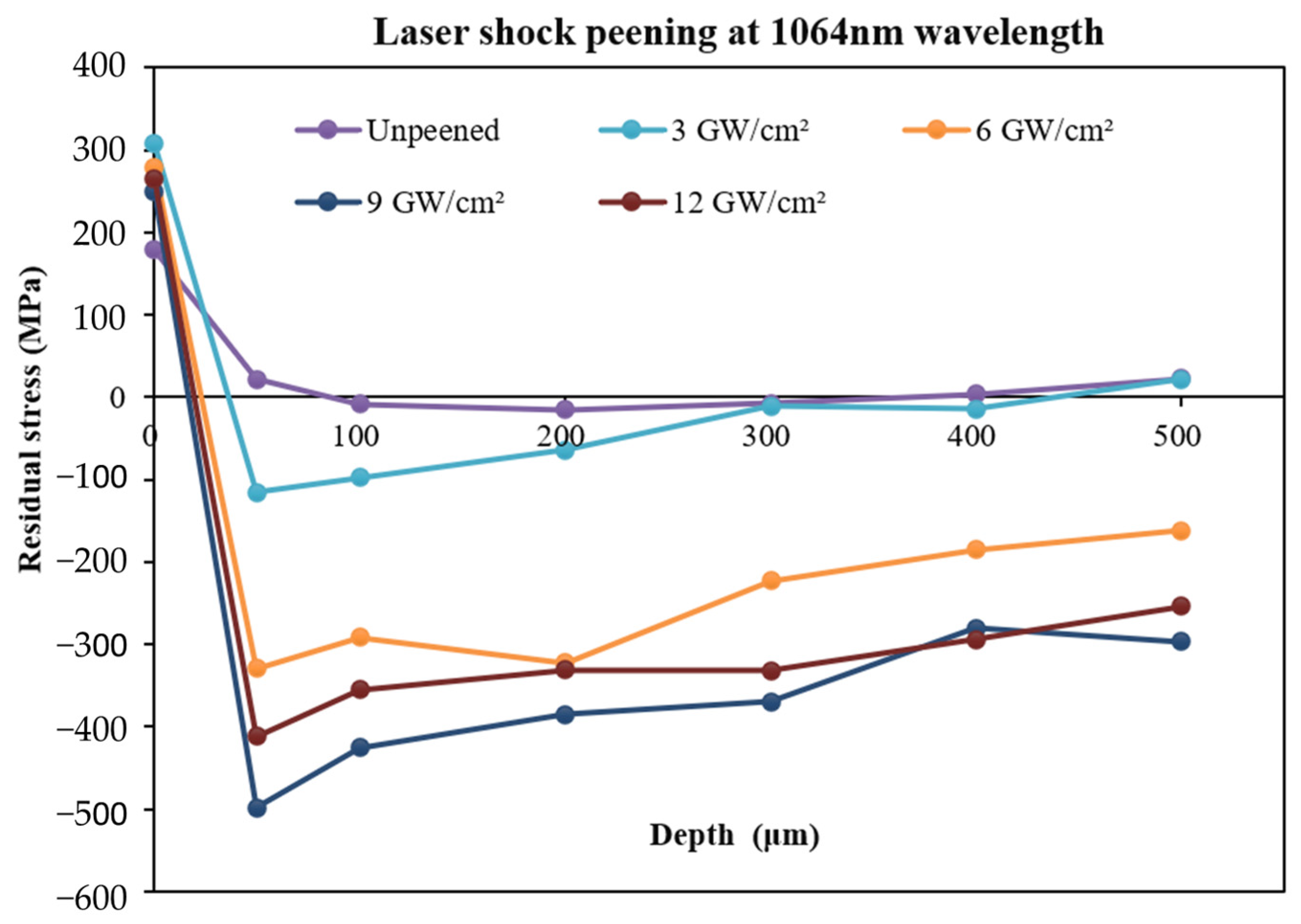

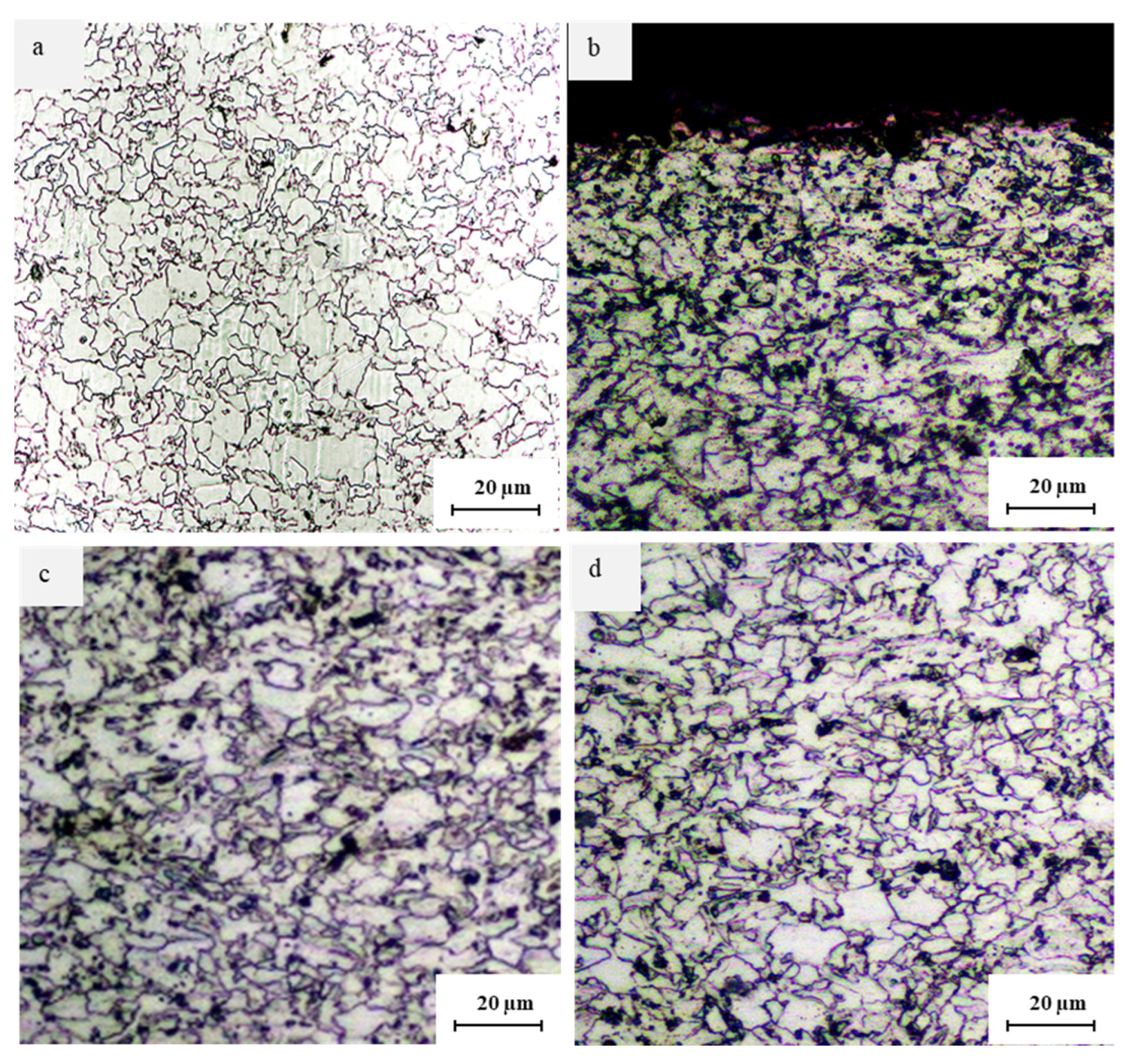
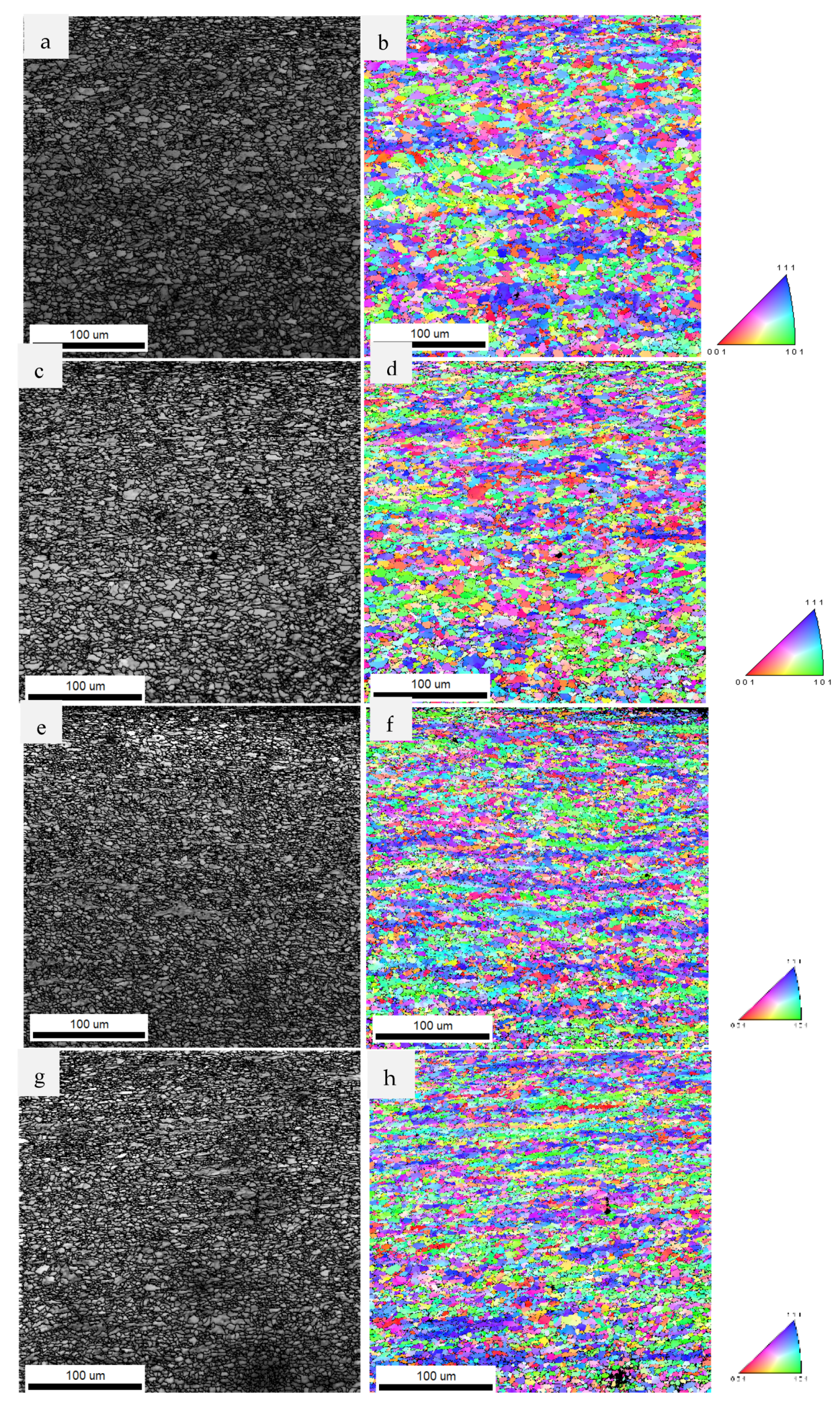
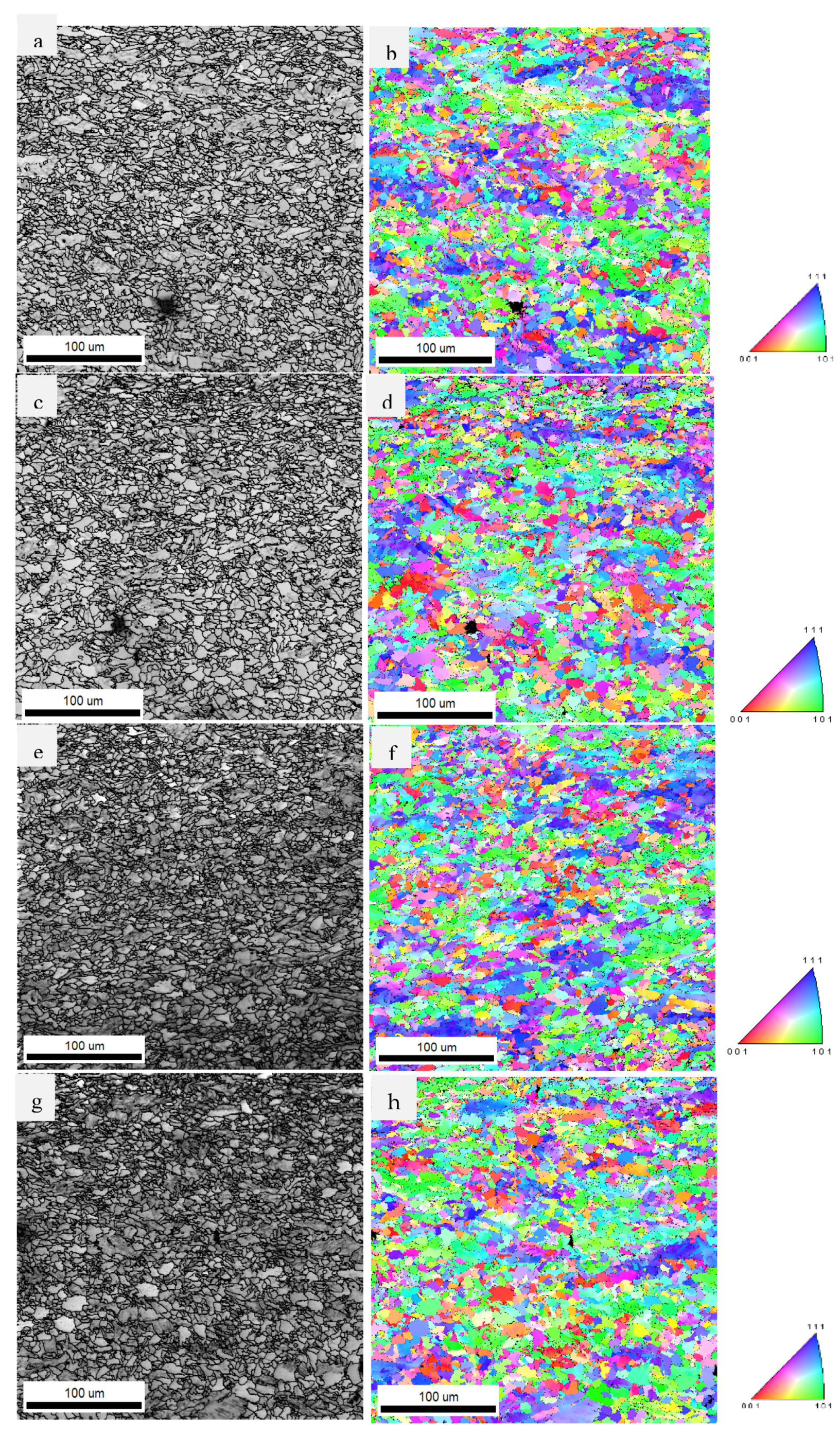
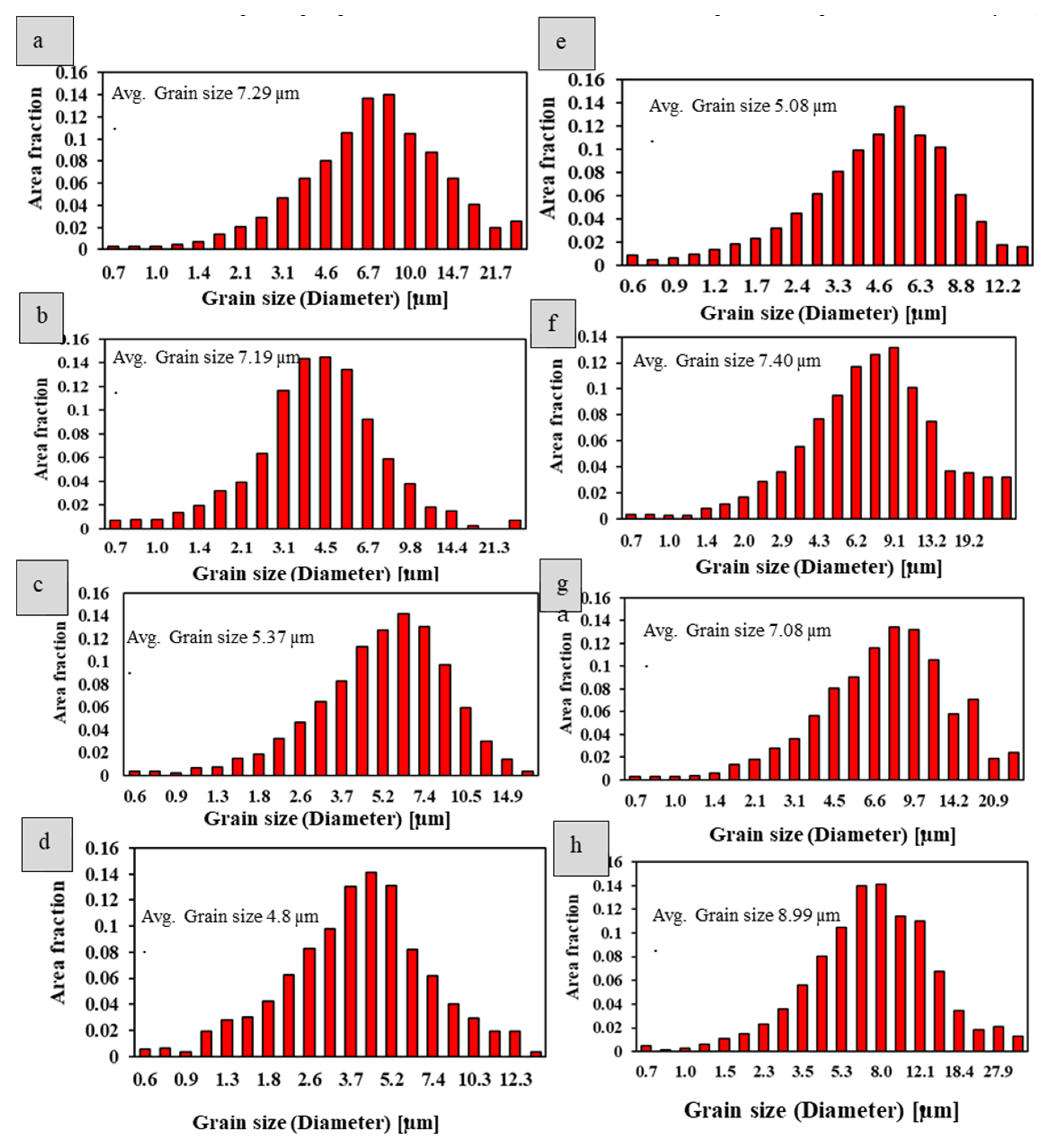

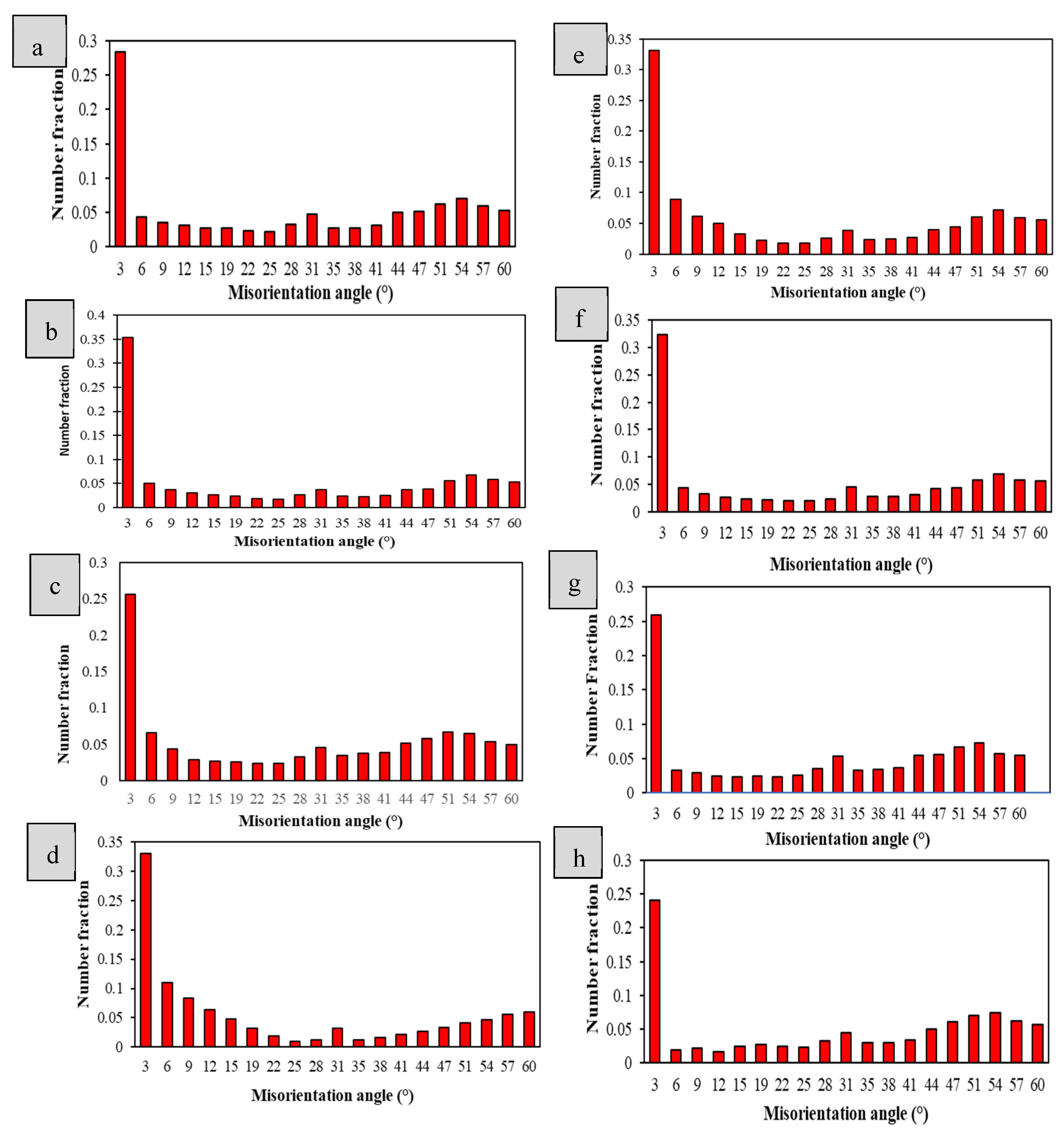

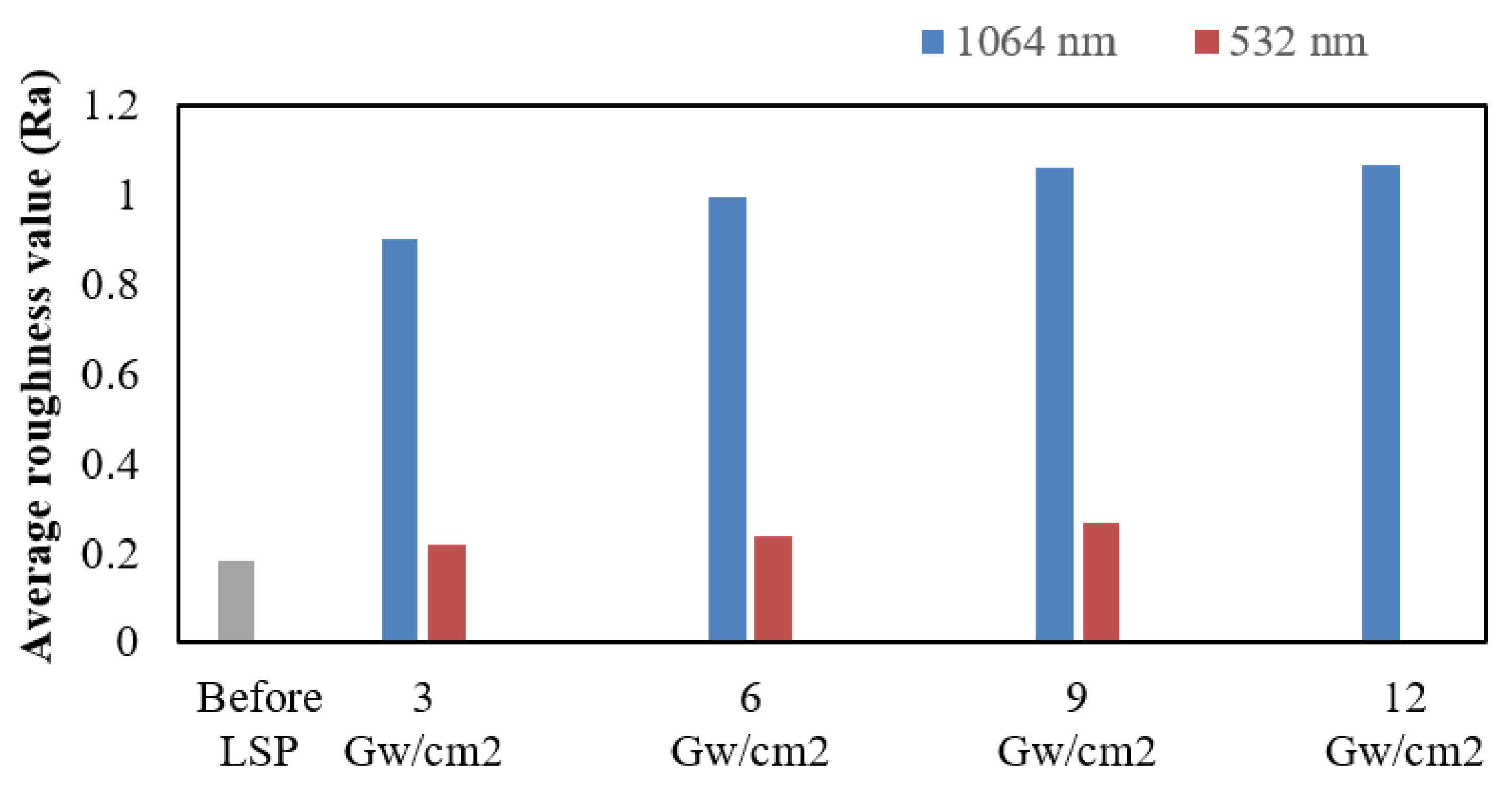
| S. No. | A2 Electrolyte Composition | Percentage (%) |
|---|---|---|
| 1 | Ethanol | 73.14 |
| 2 | 2n-Butoxy | 10.02 |
| 3 | Perchloric acid | 7.8 |
| 4 | Distilled Water | 9.017 |
Disclaimer/Publisher’s Note: The statements, opinions and data contained in all publications are solely those of the individual author(s) and contributor(s) and not of MDPI and/or the editor(s). MDPI and/or the editor(s) disclaim responsibility for any injury to people or property resulting from any ideas, methods, instructions or products referred to in the content. |
© 2023 by the authors. Licensee MDPI, Basel, Switzerland. This article is an open access article distributed under the terms and conditions of the Creative Commons Attribution (CC BY) license (https://creativecommons.org/licenses/by/4.0/).
Share and Cite
Samuel, C.; MOGANRAJ, A.; Swaroop, S.; Praveenkumar, K.; Natarajan, A.; Nageshwara Rao, M.; Syed, B.; Bhattacharya, B. Effect of Laser Shock Peening without Coating on Grain Size and Residual Stress Distribution in a Microalloyed Steel Grade. Crystals 2023, 13, 212. https://doi.org/10.3390/cryst13020212
Samuel C, MOGANRAJ A, Swaroop S, Praveenkumar K, Natarajan A, Nageshwara Rao M, Syed B, Bhattacharya B. Effect of Laser Shock Peening without Coating on Grain Size and Residual Stress Distribution in a Microalloyed Steel Grade. Crystals. 2023; 13(2):212. https://doi.org/10.3390/cryst13020212
Chicago/Turabian StyleSamuel, Calvin, Arivarasu MOGANRAJ, Sathya Swaroop, K. Praveenkumar, Arivazhagan Natarajan, Muktinutalapati Nageshwara Rao, Badirujjaman Syed, and Basudev Bhattacharya. 2023. "Effect of Laser Shock Peening without Coating on Grain Size and Residual Stress Distribution in a Microalloyed Steel Grade" Crystals 13, no. 2: 212. https://doi.org/10.3390/cryst13020212






